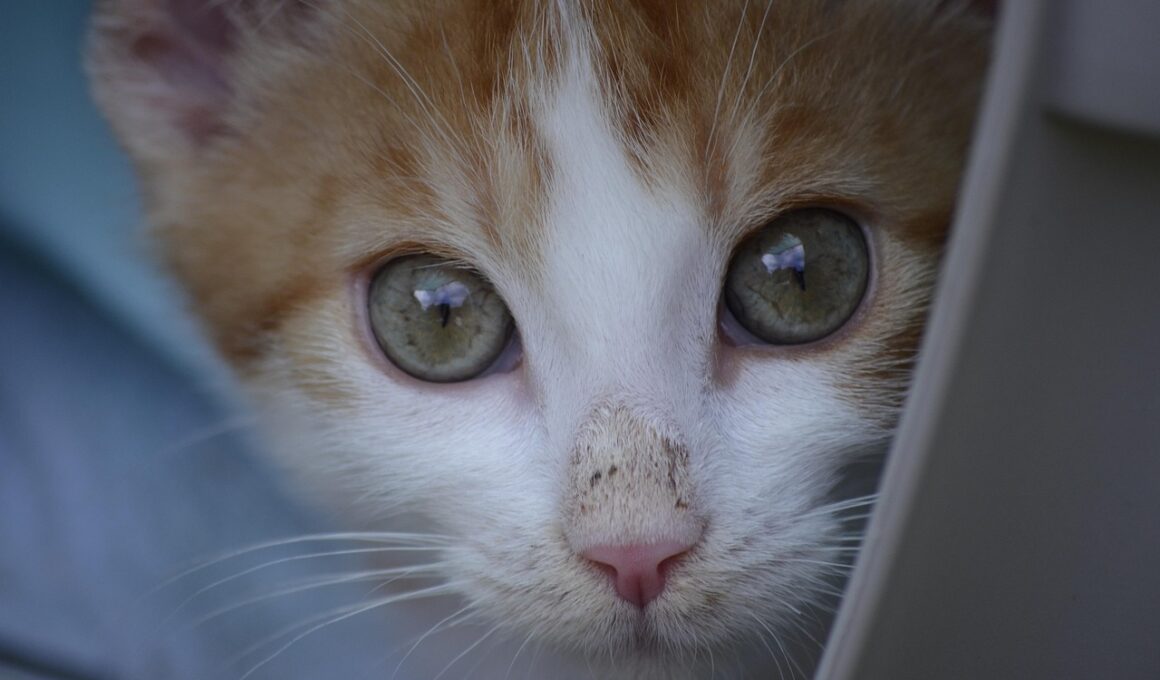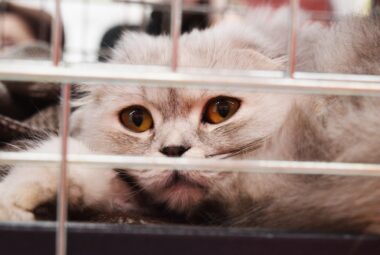Case Studies: Rehabilitation of Cats After Abuse
Cat rescue stories often highlight the severe impacts of abuse on felines. Many cats end up in shelters, traumatized, and fearful. This can be due to neglect or physical abuse, leaving lasting psychological scars. Rehabilitation of these cats is a process needing patience and understanding. Furthermore, experienced foster homes play a vital role in the recovery journey. Each rescued cat requires a tailored plan for rehabilitation. Some cats respond well to gentle handling, while others may need more space initially. Assessing a cat’s individual needs is crucial, as excessive stress can hinder progress. Engaging with veterinarians, behaviorists, and shelters is an essential step in creating a suitable environment for recovery. Additionally, socializing with other friendly cats can help ease the trauma. Rescue organizations often provide resources to aid rehabilitation, including providing shelters with behavioral training for volunteers. Community efforts to educate the public on responsible pet ownership is vital in reducing the number of rescues. Success stories arise from collaborative efforts between the rescue teams, fosters, and dedicated adopters. In conclusion, advocacy for cats and community involvement is essential in transforming lives tormented by abuse.
Understanding the Impact of Abuse
Abuse and neglect cause severe emotional trauma to cats, affecting their behavior and overall health. A common response is withdrawal or aggression; cats often feel threatened. They may exhibit fearful behaviors, such as hiding, hissing, or refusing to eat. This reaction can severely limit their adoptability, making rehabilitation more challenging. Recognizing these patterns helps caregivers provide suitable environments for recovery. Providing safe spaces helps in reducing anxiety; utilizing simple techniques can aid their adjustment. Consistency in daily routines supports a feeling of security, promoting healing. Furthermore, the physical environment can influence recovery; soft beds, quiet areas, and climbing spaces are beneficial. Patience is key; rushing a cat into new situations may hinder progress. Additionally, employing calming products, such as pheromones, can create a more relaxed atmosphere. Enrichment through toys and interactive play encourages mental stimulation, enhancing recovery. Understanding feline body language fosters better communication between humans and cats, making a significant difference in the rehabilitation process. Effectively preventing re-abuse involves educating potential adopters about the specific needs of rehabilitated cats. Success in rehabilitation journeys hinges on collaboration and empathy, ensuring a brighter future for every abused cat.
The recovery process often unfolds in distinct stages, each requiring different approaches to care and support. Initial steps may involve medical assessments to address any physical ailments, including injuries caused by abuse. This comprehensive checkup is vital for ensuring that the cat receives appropriate medical attention. Concurrently, behavioral assessments help identify specific needs, establishing a baseline for rehabilitation efforts. Once the basic needs are met, the focus shifts to creating a nurturing environment. Building trust is essential; caregivers can facilitate this through gentle handling and quiet interactions. Gradually introducing human presence helps mitigate anxiety. Likewise, offering positive reinforcements for brave behaviors contributes significantly to the cat’s confidence. Rescue organizations often provide training sessions for foster caregivers, ensuring that they are equipped with the necessary skills for successful rehabilitation. Employing various training techniques tailored to each individual cat’s personality fosters a supportive learning environment, promoting self-discovery and exploration. The ultimate aim is to prepare these cats for adoption into loving homes, where they can finally feel secure and safe. Monitoring progress and adjusting plans accordingly helps ensure that every cat receives the help it requires throughout its journey to recovery.
Success Stories that Inspire
Success stories of cat rehabilitation serve as powerful inspirations for both volunteers and adopters. One poignant example involves a cat named Lucky, discovered in an abandoned building, emaciated and terrified. After months of patient care and love, he transformed into a playful companion, showcasing resilience. Stories like Lucky’s remind us of the impact individuals can have through dedication and compassionate care. Similarly, another cat, Bella, was rescued from an abusive situation involving neglect. Initially distrustful, Bella gradually learned to trust her foster family through gentle handling and consistent routines. After months of nurturing, she blossomed into a friendly, loving cat, ultimately finding a forever home. Such transformations highlight the importance of understanding feline behavior, while advocating for humane treatment. Furthermore, these stories encourage community engagement in rescue efforts. Many shelters and rescues share such tales to raise awareness and funds necessary for ongoing operations. Individuals touched by these stories often become advocates themselves, helping rescue more cats. Every success story illuminates the path forward, revealing the potential for healing and the extraordinary bravery within the feline spirit. Through these transformations, countless cats find their second chance at happiness.
A key element in successful rehabilitation involves educating potential adopters about the unique needs of previously abused cats. Providing resources for future owners is crucial to ensuring a smooth transition into a new home. Many shelters often offer workshops and informational materials to guide adopters through this process. Understanding specific challenges and behavioral considerations fosters realistic expectations, ultimately leading to healthier relationships. Patience is essential, as newly rehabilitated cats might require time to adjust to their new environments. Each cat’s timeline varies; some may adapt quickly, while others need a gradual approach. Fostering connections between potential adopters and behavioral specialists can also provide additional insights and support. Additionally, follow-up programs play a significant role in offering continued assistance. Regular check-ins encourage open communication and help address any issues that arise post-adoption. This ongoing support reinforces the commitment to care and maintain well-being. By equipping adopters with knowledge and resources, the likelihood of successful adoptions increases, breaking the cycle of abuse. Ultimately, creating supportive communities is essential for elevating the standard of care that every cat deserves, ensuring brighter futures for every life affected by hardship.
Long-term Commitment to Cat Welfare
Rehabilitation of abused cats presents an ongoing commitment to ensuring their well-being and happiness. The process extends beyond immediate recovery; fostering long-term care necessitates dedicated support systems for each cat. These systems involve collaboration among shelters, volunteers, veterinary professionals, and adopters, ensuring comprehensive care from rescue to forever home. Regular health check-ups are imperative for sustaining well-being, as ongoing medical needs may arise from previous abuse. Continued socialization and training help build confidence, while positive reinforcement strengthens human-animal bonds. Engaging with the community is equally crucial; raising public awareness can reduce future abuse incidents. Educating others about the joy of rescue also fosters positive perceptions of previously abused cats. Moreover, fundraising supports shelter operations, allowing for more rescues and rehabilitative services. Volunteer programs also encourage individuals to engage with local rescues, fostering empathy and understanding. Ultimately, every step forward in cat welfare creates a ripple effect throughout communities, emphasizing the importance of focusing on humane treatment and rescue efforts. By harnessing collective power and compassion, we can ensure lasting change for countless cats suffering from abuse, paving the way towards a brighter future filled with love.
In conclusion, cat rescue and rehabilitation illustrate the profound impact of compassion and dedication towards rehabilitating felines who have endured abuse. Various post-abuse rehabilitation techniques champion a holistic approach tailored to individual needs. By fostering patience, understanding, and community efforts, these felines can find their places in loving homes. Addressing the psychological and physical implications of abuse proves essential to fostering recovery and successful adoption. Each step toward rehabilitating these courageous cats serves as a testament to their bravery in overcoming hardship. A proactive approach that values education and community engagement enhances overall success, promoting informed adoptions and sustainable lifelong care. Community outreach programs raise awareness about responsible pet ownership, helping to prevent cycles of abuse. Success stories serve as powerful reminders of the resilience of animals, showcasing the importance of providing second chances. Ultimately, a collaborative effort ensures that every rescued cat has the opportunity to heal, thrive, and become cherished members of their new families. Advocacy for cat welfare remains crucial; with continued efforts and dedication, we can create safer and kinder futures for countless felines. The journey of rehabilitation showcases the transformative power of love and patience.





